
Vol. III No. 28. Reg. No. L5015 Delhi, Thursday March 22, 1945. British 36th Occupies Mogok Chinese 50th Division troops of Lt. Gen. Dan I. Sultan's Northern Combat Area Command are mopping up around Hsipaw, as British 36th Division units occupied the ruby center of Mogok, second main objective of the three-pronged drive initiated by the American commander into Central Burma. In the meantime, the British 14th Army has entirely surrounded Mandalay, with only a suicide garrison inside Fort Dufferin remaining of the Nip defenders of the city. The Nips have been pounded by land artillery and rocket fire from the air, but seem willing to fight to the last in typical Japanese fashion. British units which seized the Meiktila air strips are encountering considerable opposition in the area. One of the hardest battles of the Burma campaign is expected when the British come up against the enemy elements trapped between Meiktila and Mandalay. The Chinese 50th Division troops of Maj. Gen. Pan Yue-kun have consolidated their positions inside Hsipaw. But to the northwest, northeast and north, pockets of Nips have burrowed in and will have to be wiped out. Another pocket of Japs have dug themselves in to the south of the town on a hill. The First Chinese Army of Lt. Gen. Sun Li-jen is driving southwest along the Road from Lashio, with only 29 miles separating them from the 50th Division. Other First Army units are progressing south and southeast from the road to Mongyai, with leading elements only 20 miles from Lashio. Maj. Gen. Francis W. Festing's veteran 36th British has control of the western drive of the Sultan forces. Facing light opposition at first, the 36th encountered tough opposition along the road to Mogok. Japs have dug into the hills. Earlier in the week the 14th Army seized Maymyo, cutting another escape route of the Japs from the Mandalay area. Fly Warm Eggs From Calcutta To Ledo Area CALCUTTA - Less than 24 hours after the hen cackles in Madras (indicating the drop of an egg) the boys in the Ledo area are having them sunny side up or once over lightly. This is the result of a speedy chicken to candling service operated by the members of a General Depot warehouse unit functioning in the Calcutta area. "The egg service to the boys up-country works so fast that sometimes they are still warm when they arrive," brags Cpl. Robert C. Grice, who has supervision of the candling routine. "And I don't mean just a few dozens of eggs; I mean thousands upon thousands." ENOUGH FOR EASTER Pfc. Louis J. Elmore, who is in on the processing, firmly believes that the chickens, like the warehousemen candling the eggs, are working on a 24-hour war basis. "During the past few weeks," Elmore maintains, "I've seen enough eggs to fill every basket in the United States for the coming Easter season, including the egg-rolling on the White House lawn." Approximately 70,000 eggs a week are flown here from Madras each evening for candling. Early the next morning they are placed aboard a fast plane which lands them up-country in time for breakfast. The eggs are candled for blood spots, meat, spots, stuck yolks, seepy yokes and broken yolks. HENS ON THE BALL A former professional photographer from the Bronx, N.Y., Pvt. Raymond Hanson, another processor on the job, says that very few of the eggs, are found to be unfit for consumption. "The chickens must be on the ball, considering the small number of eggs which are discarded, and you can take it from me that they're laying their part in this war." Just how many eggs the boys have candled since the over-night service started must remain a military secret for the present, but it's a cinch that if they were all broken open they would make an omelet which would come pretty close to serving nearly all of the G.I.'s in the India-Burma Theater.
|
|
Stimson Announces 839,589 Casualties In War Thus Far WASHINGTON - (ANS) - Army Ground Force casualties for February on the Western Front dropped to 34,468, lowest figure in three months, War Secretary Henry Stimson announced this week. Overall casualties are now 839,589, an increase of 15,956 in the last week, he added, giving a breakdown as follows: 180,671 dead, 492,209 wounded, 100,139 missing and 66,570 prisoners of war. Stimson said the Allies Rhine bridgehead at Remagen was now well consolidated and prepared to deal with possible heavy German counter-attacks, the Nazis having lost their best chance to eliminate the salient by not reacting swiftly after the original crossing. 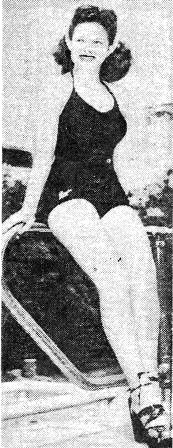 It's old but it's always new, "in the spring a young man's fancy turns to," and why not Jo-Carroll Dennison of
Hollywood. Even in the Orient we have spring, or something simulated thereof.
It's old but it's always new, "in the spring a young man's fancy turns to," and why not Jo-Carroll Dennison of
Hollywood. Even in the Orient we have spring, or something simulated thereof.
TONI ATTACKS BRASS HATS ON PINUPS Toni Seven, chosen as Miss Cheesecake of 1944 by the Paris edition of Stars And Stripes, this week attacked "stuffy officers who make the men tear pinup pictures off their walls." According to the United Press, Miss Seven heard that pictures of her delectable legs had been ordered ripped from the walls of American air bases in England. In language dear to the heart of Roundup cheesecake lovers she blasted the brass with the following: "They can't do that to the boys. If they want more leg pictures I'll have a new photo made tomorrow. I'd rather be court-martialed than stop sending our boys anything they want." She said she received more than 2,000 letters weekly from troops overseas and that most of them needed "plasma and pinups." She claimed to have sent more than 1,000,000 pictures of herself, plus her legs, all over the world. "If only those stuffy officers could read the letters written to me by troops they'd give priority to pinup pictures instead of tearing them down. The boys are fighting for a symbol and that symbol is the girl at home. If I happen to be that symbol to some of them, then they'll continue to get my pictures no matter what." (So if any of you India-Burma G.I.'s lack pinups, write Miss Seven. We don't know her home address, but send your request to Darrell Berrigan at United Press, 220 E. 42nd St., New York City. He forwarded the story, and as an old CBI correspondent should be able to transmit the requests through the proper channels.) |
War's Longest Fighter Sweep Flown By EAC
HQ., EAC - A week in which Eastern Air Command made heavy and repeated attacks against Japanese troops and supplies in Burma came to a brilliant conclusion with a smashing blow against the enemy air force.
American and British aircraft have made the sky over Burma a deathtrap for enemy aircraft and with the capture of the airstrips at Meiktila the Japanese lost the most advanced bases from which they made occasional attacks.
Gradually their planes have been withdrawn further and further away from the battlefront and on the Don Muang Airfield, near Bangkok, the Japs must have supposed that they were completely safe. Their error was grimly demonstrated to them by USAAF Air Commando fighters.
LONGEST FLIGHT
After days of the most careful planning, squadrons of Mustangs swooped on Don Muang on the longest fighter offensive mission ever flown in any theater of war - a round-trip of 1,500 miles.
Jap aircraft were scattered all around the field as the Americans swooped down. For the cost of only one of their number, the P-51's scored the following results:
Destroyed on the ground: 13 twin-engine, two single engine and one unidentified aircraft; probably destroyed on the ground: four twin-engine; damaged on the ground:13 twin-engine and two single-engine bombers.
SIAM NO REFUGE
The Air Commando fighters raked the airfield buildings with their .50 caliber bullets, damaging the control tower, hangars, and radio installations, before turning back for their long flight home. The Japanese have now learned that Siam offers no refuge to their aircraft.
The emphasis of other operations during the week was on attacks against enemy supplies and supply routes. Twice within 48 hours USAAF B-24's and RAF Liberators struck at the great storage dumps at Rangoon. The dumps at Prome were also hit by heavies, while B-25's have made repeated attacks on similar dumps nearer the Mandalay battlefront.
COMBAT CARGO
The destruction of supplies so near Mandalay was particularly harassing to the Nips, who also had to watch the Combat Cargo Task Force transports delivering the goods of war to British ground forces in the heart of the combat zone.
In five days these aircraft dropped 90,000 rations, 50,000 gallons of gasoline, ammunition, 500,000 cigarettes, bread, vitamin tablets and rum - even a special supply of oil for flame-throwing tanks.
There was also the usual destruction of bridges, particularly on the Burma-Siam Railroad, though the Rangoon-Mandalay line also came in for some attention. In the Northern Combat Area Command stores, communications, and troop concentrations have been bombed and strafed.
One innovation was made during this period. It was revealed that heavy bombers of the RAF, Ceylon, had attacked Jap shipping off the North Burma coast.
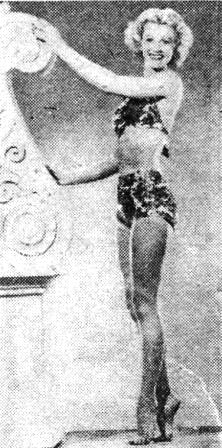 Elaine Bacon of Hollywood Models Guild says she likes this suit. So do we, and what's in it. So we're running it.
Elaine Bacon of Hollywood Models Guild says she likes this suit. So do we, and what's in it. So we're running it.
|
Jungle Angels Now Identified As 5th Liaison
HQ., EAC - The presence of the USAAF Fifth Liaison Squadron, the "Jungle Angels," has been officially announced this week. The squadron operates under the 10th Air Force of Eastern Air Command.
The squadron has had a variety of duties to perform since coming to the Theater in April, 1944. Evacuation of wounded, adjusting P-47 bombing and ground artillery fire, dropping medical supplies, conducting search missions and taking forward area photos are among their contributions to wiping out the Jap.
Most of the pilots of the Fifth, as well as
|
Tiny L-5's, L-4's and L-1's of the Fifth participated in the Mogaung-Kamaing Valley drive, the Ft. Hertz Valley campaign, the push down the railroad corridor with the British 36th Division, the siege of Myitkyina and Bhamo, and the recent successful opening of the Burma Road.
The Fifth was activated in April, 1943, at Cox Army Airfield, Paris, Tex., personnel being recruited from the old First Balloon Squadron of the AAF. Commanding officer of the Fifth is Capt. Gari King of Detroit, while operations officer is Capt. Harold G. Bradshaw of Salinas, Calif.
Outstanding missions of the Fifth were flown during the Myitkyina battle, when 3,000 sorties were undertaken from an airstrip under enemy fire. The little craft have landed on dried rice fields, narrow roads, sand bars and beaches, and jungle clearings.
To illustrate: T/Sgt. Clifford Bryan of Pacicines, Calif., flew more than 80 missions in a 33-day period; T/Sgt. Rexford A. Davis of Shreveport, la., evacuated 55 wounded soldiers in one day; Sgt. Walter benedict, Washington, D.C., took over an artillery adjustment sortie for four hours during bad weather. Silver Stars were earned by T/Sgt. Carl W. Hughes, Sheldon, Mo., and S/Sgt. George L. Buzzard, Joplin, Mo.
FOUR G.I. NIMRODS BAG TWO TIGERS IN ASSAM
HQ., 10TH AIR FORCE, BURMA - Four enlisted men of the 10th Air Force "Flying Lyons" fighter squadron recently came out of the Assam wilds with the tiger hunt story to end all tiger hunt stories.
Armed with Springfield rifles, two carbines, a Mauser pistol, a shotgun and three-day passes, Sgts. Vern Pudas, Carter Collins and Jess Collins and S/Sgt. Jim Smith traveled 24 hours from their base to reach tiger country. On the scene, Indian farmers told the hunters that marauding tigers were killing off livestock at the rate of almost one a day. One farmer, attempting to defend his property, had been badly clawed by the animals.
From the farm the hunt led to the middle of a dried-up river where a number of Indians volunteered to act as beaters. As the beaters flushed the brush, the hunters stood by with weapons ready. Eventually the bushes parted and a huge tiger burst into view. Pudas snapped the Springfield to his shoulder and killed the animal with one shot. At the same instant, the dead animal's mate bounded upon the scene, and the eager, dismounted Air Corps men fired from all sides, dropping the tiger for the count.
The intrepid hunters measured their catch and found the male to be 16 feet from tip to tip, while the female stretched 12 feet. The combined weight of the two prizes totaled nearly a thousand pounds.
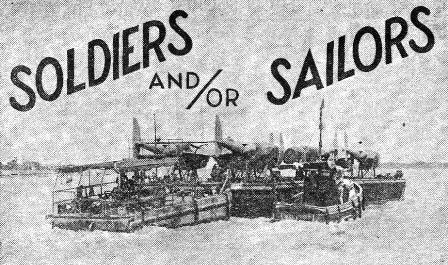 Here the Army sailors take a load of P-38 fighter planes upriver for air squadrons operating in Burma and
China. Two American Barge Line tugs, a Mule at the left and a MTL at right, push the heavily-laden barge from
the ships to the jetty only 100 yards from the airfield where the planes will be
readied to take off to blast
at the Japs.
Here the Army sailors take a load of P-38 fighter planes upriver for air squadrons operating in Burma and
China. Two American Barge Line tugs, a Mule at the left and a MTL at right, push the heavily-laden barge from
the ships to the jetty only 100 yards from the airfield where the planes will be
readied to take off to blast
at the Japs.
|
CALCUTTA, INDIA - The Army's all mixed up with the Navy to a large group of "aquatic" soldiers in Calcutta.
Working on boats with such terms as "stow the cargo," "cast off," "make it ship-shape," "hard a port," and "put 'er astern." is all out of keeping with a first sergeant's bark to "fall in," "on the double," "hut-tup-tree-four," and "fall-out." And then trying to keep Army and Navy uniforms straight is a bit trying - Navy blues and white sailor caps while at work, the Army khaki and O.D. for dress formations and on pass in town.
This being in the Army and doing "Navy" work is the unusual occupation of members of harbor craft companies operating the American Barge Line in and near the Army port of Calcutta.
THOUSANDS OF TONS
Each month the barge line, which is part of Base Section No. 2, SOS, India-Burma Theater, moves thousands of tons of general cargo and millions of gallons of gasoline - much of which finds its way to China over the Stilwell Road by truck and by plane over The Hump.
The American barge Line was organized to assist in the moving of supplies through the port, which leads military installations throughout the world in the handling of materials of war. Every method of transportation has been pressed into use - and with many waterways in this area, an Army organization was needed to move supplies by water.
RIVER 'KNOW-HOW'
Under the leadership of Lt. Col. L. E. Barry of Cairo, Ill., the American barge Line has received high praise for its efficient handling of supplies. Berry, former assistant operating manager of the Federal Barge Line on the Mississippi River with offices at St. Louis, brought plenty of "river know-how" to aid in setting up the barge line.
The men of the harbor craft companies, though much of their work is "outside" the harbor, were molded into units back in the States. Half of the men had some type of experience on the water, while the other half were from all types of civilian trades, from farmer to funeral director.
Some of the soldiers only experience with water, other than washing in it or drinking it, had been riding ferry boats or a rowboat on a city park lake. But now, you can't tell the old hands from the rookies -
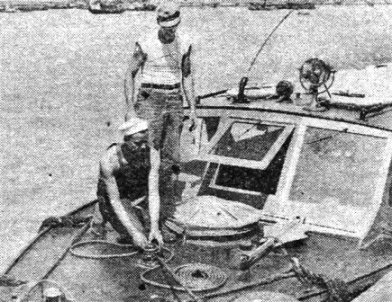 It wasn't so long ago that T/5 Arthur Devoe of Buffalo was trampling the hills of North Burma and killing
Japs with Merrill's Marauders. Here he is learning how to moor a boat under the expert eye of Sgt. Leo
Sorenson of Marinette, Wis. These boys are working on a "J" boat of the American Barge Line which operates
on the waterways around Calcutta moving supplies.
It wasn't so long ago that T/5 Arthur Devoe of Buffalo was trampling the hills of North Burma and killing
Japs with Merrill's Marauders. Here he is learning how to moor a boat under the expert eye of Sgt. Leo
Sorenson of Marinette, Wis. These boys are working on a "J" boat of the American Barge Line which operates
on the waterways around Calcutta moving supplies.
|
Among some of the older seamen are Sgt. David Clancy and Sgt. W. W. Wagner. Clancy, a product of County Cork, Ireland, has sailed on every type vessel afloat - except a whaler. From London and Southampton he shipped as an engineer on passenger boats to South Africa and South America, holding a second engineer's rating
It was in 1942 when his ship, sailing under the colors of the Free French, docked in New York. Clancy was taken off the ship very ill to a hospital. He stayed in New York, married, joined the Army and received his citizenship papers. Now he's in charge of maintenance of all the harbor boats of his organization in Calcutta.
Wagner, who served with the U.S. Navy from 1926 to 1934 on the battleship Pennsylvania, hails from Fostoria, O., was a foreman and metal worker instructor when he was called up.
In contrast, there is T/5 Arthur Devoe of Buffalo, N.Y., a veteran of 13 months with Merrill's Marauders. Devoe was hospitalized for a while; when he was released he was assigned to a craft company.
Or there is T/5 Gordon Bittermann of Wheaton, Ill., a former funeral director; Sgt. Leo Sorenson of Marinette, Wis., an ex-clerk; Sgt. John Rich of Clark Hill, S.C., a farmer, or T/5 Burton Kostol of Minneapolis, Minn., a dairyman.
Then again experience tempers the rookie boatmen with men from the Alaskan tanker run - T/5 James W. Soverign and Sgt. Iver Bugge, both of Seattle, Wash.; Sgt. Herman T. Jamerson of Port Lavaca, Tex., who has sailed the Gulf of Mexico with shrimp boats for 14 years; or Sgt. Charles Bevis of Miami, Fla., who ran deep sea fishing cruises for 10 years off the Florida Keys.
One run from the barge line takes the men through the Sunderbans, the wild, sparsely-inhabited country at the mouth of the Ganges and Hooghly rivers, which is reminiscent of the lower reaches of the Mississippi River, the Everglades of Florida and the bayous of Louisiana.
The country abounds with treacherous swamps and many uncharted canals, by-passes and streams. It is the home of the Bengal tiger and great numbers of deer, and in its waterways are found the blunt nosed crocodile.
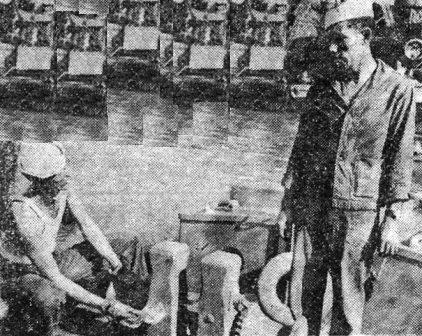 It's paint, paint and paint in the water Army. Sgt. Charles Bevis, Miami, wields a paint brush while
chatting with Sgt. Benion Dendy, Texarkana, Tex. Bevis was a deep-sea fisherman. Dendy was on coastline
tankers.
It's paint, paint and paint in the water Army. Sgt. Charles Bevis, Miami, wields a paint brush while
chatting with Sgt. Benion Dendy, Texarkana, Tex. Bevis was a deep-sea fisherman. Dendy was on coastline
tankers.
|
INDIAN PILOTS
Because of the poorly marked channels and the danger of getting lost, and grounding, the boats and barges are usually tied up overnight. As a safety precaution, Indian pilots are carried aboard on most of the operations.
The men live on the boats for periods as long as two weeks without getting back to their home base - cooking, washing their clothes, and doing all the chores of living on board a boat. Their only communication with their base is through a network of radios.
MOSTLY UNCHARTED
When the operation was first started about a year ago, all river pilots, commercial steamer lines and old river men were pumped for information concerning these many poorly chartered waterways. Some of the channels are marked for river steamers, but most of them are uncharted passages.
On the Hooghly River run, the channels are well marked - but the number of ships, barges, riverboats and warships which ply the busy river keeps the soldier navy on its toes. "The rule of the river traffic is just to keep out of each other's way," comments Sorenson who wouldn't give up his job to go back into an office where he used to hold forth as a civilian.
HAUL AIRCRAFT
One of the big jobs on the river for the barge line is the hauling of fully-assembled aircraft from the decks of ships to within 100 yards of an airstrip where the planes are prepared for flight. Without the barge line's 104-foot long and 29-foot wide steel barges and its tugboats, fully assembled aircraft could not be brought into Calcutta.
The city's narrow, crowded streets cannot accommodate the planes, so the only method is to take them off the ships, put the planes on barges and push them up the river to the base. In February, the number of planes handled by the barge line was in the hundreds.
CAPACITY 300 TONS
The steel barges, a night-and-day improvement over the wooden barges first used, can handle 300 tons dry cargo or 80 to 90,000 gallons of gasoline.
Most of the equipment used by the barge line has been assembled by the outfits working in conjunction with the engineers. The line now possesses numerous cranes capable of handling 30 tons.
SEA MULE
Two types of boats are used to push or tow the steel barges. The MTL boat is a 47-foot long, wood-hulled craft with a 150 horsepower engine. This boat is large enough to carry bunks and other facilities for the crew.
The other type is the GT or marine tractor, better known as the Sea Mule. These are twin-screwed boats with two 125 horsepower engines. On many of the heavier loads and against difficult river conditions, both types are used.
HAULS EVERYTHING
The barge line has hauled all types of equipment and supplies including heavy manufacturing machinery, sheet steel, ammunition, foodstuffs, airplane engines and equipment, and personnel. The barge line also has many side jobs such as operating the fireboat in the harbor, assisting the engineers in dredging and jetty-building operations, hauling passengers, maneuvering targets for bombing practice of Allied aircraft, and even supplying a boat for a survey of fishing prospects for the Army in the Bay of Bengal.
Sometimes it's confusing whether this work is the function of the Army or the Navy. But when the supplies go through, it doesn't make much difference if it's Navy blue or Army khaki, and these boys have both.
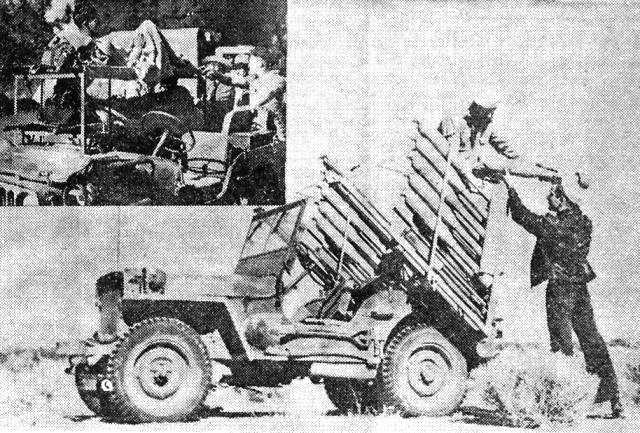 The jeep is a fabulous creature. At top left, one of the creatures, built with a double tier of stretchers,
serves as an ambulance for the British and American First Air Commando Medics operating near Mandalay. And at
right at Inyokern, Calif. Navy Engineers experiment with the jeep as a rocket platform.
The jeep is a fabulous creature. At top left, one of the creatures, built with a double tier of stretchers,
serves as an ambulance for the British and American First Air Commando Medics operating near Mandalay. And at
right at Inyokern, Calif. Navy Engineers experiment with the jeep as a rocket platform.
|
158 I-B Men
Awarded Citations
Six DFC's, 95 Air medals, three Soldier's Medals and 50 Oak Leaf Clusters to the Air Medal were given to members of a heavy combat mapping squadron in a recent ceremony at the unit's base in India to feature award presentations in the Theater.
Capt. Vernon L. Morris of Ramah, Colo., pilot of the 490th Medium Bombardment Squadron, was awarded the Silver Star after piloting a badly-crippled B-25 130 miles out of enemy territory and landing it safely at an Allied base with its crew.
ON ONE ENGINE
After his plane had the left engine knocked out by ack-ack, Morris skillfully maneuvered the craft over nearby hills. On the way home, sometimes not making more than 100 miles an hour, Morris skimmed hills and trees. He kept the single engine going for an hour and a quarter until he reached the landing field.
The Soldier's Medal was pinned on Capt. Noel Cipriano, Northern Combat Area Command censor, by Lt. Gen. Dan I. Sultan at Theater Headquarters this week. Cipriano saved an enlisted man from possible death after the G.I. had ignited himself with gasoline.
FLYING TACKLE
One arm and all his clothing burning, the sergeant dashed out of his basha at Myitkyina. Cipriano, who was nearby, cried to the sergeant to roll himself on the ground. Crazed by pain, the sergeant continued to run in circles, fanning the flames. Cipriano hit him with a flying tackle and beat out the flames. As Sultan pinned on the medal he smilingly remarked, "It's not every day I give a medal to a censor."
Col. Karl R. Lundeberg of the Medical Corps and Maj. John A. Wester, Signal Corps, were given Legions of Merit.
Lundeberg's award was pinned on by Maj. Gen. W. E. R. Covell, Commanding General of SOS. The colonel served as chief of division of epidemiology and preventive medicine, Surgeon General's Office, Washington, during the period for which the award was made. He is now India-Burma Theater Medical Inspector. In his work in Washington he initiated and supervised development of new methods for improved control of communicable diseases.
|
ASC DEPOT, AGRA - For eight months Sgt. Steve Orlowski kept unopened in his footlocker the quart bottle of Ovaltine sent him by his family in Chicago. Steve doesn't like Ovaltine. Recently he submitted it, with other things, to Capt. Charles Stalter for censorship, intending to send it back home. Fascinated by the first Ovaltine he had ever seen in liquid form, Stalter tasted some. Then Steve tasted it, then everybody tasted it. The verdict was unanimous - Canadian Club. Steve saved his postage. |
Bridge Built In Eight Days
GEN. SULTAN'S HQ., BURMA - British 36th Division engineer units lay claim to a new construction record after recently completing a 765-foot two-section teakwood bridge across the rapid Shweli River at Myitson in just eight days.
Before the actual bridge-building could begin, the men had to handsaw fell 908 British Admiralty teak trees, valued at $20,000, and then haul to logs to the river bank. Iron ties and spikes were fashioned by hand from captured Jap material and 11-foot trestles were erected.
One construction gang completed 225 feet of the bridge from the Shweli's south bank to a mid-stream island in four days, while two other gangs finished construction of a 450-foot link from the north bank to the island four days later. The 700 men on the project averaged 100 feet of bridgework per day.
Believed to be the largest one of its kind ever built by a divisional engineer unit under similar circumstances, the bridge was constructed entirely without the use of a single piece of machinery.
Ah, that British ingenuity!
|
Burma Safest Place In Far East For Soldier Jewel Purchasers BUY PRICELESS GEMS AT LOWEST PRICES By S/SGT. EDGAR LAYTHA Roundup Staff Correspondent BURMA - There aren't many cheap knicknacks in Burma. Nothing is manufactured here to make the American a sucker. The PX may carry stereotyped ivory carvings or gold braided Benares bags imported from India, but the native bazaars sell almost no curios. This is so, because Northern Burma never was a tourist country. The average globetrotter rarely ventured further north from the coast than Mandalay. And Allied North Burma is comparatively empty. The bulk of the population lives in the fertile South which is still Japanese held, and the people in the North are still busy restoring their bombed villages, rehabilitating their dead paddy fields, procuring bare necessities for their kitchens. They have not yet found time to create a curio trade for military tourists. PLEASANT PICTURE But Burma is the home of jade, of the ruby and of sapphire. Relatively the safest place for the G.I. in the Far East to play with precious stones. I can tell you from personal experience, for I have watched the game in India and in China. That story is too sad and too hackneyed to be told again. Yet, here in Burma the picture is pleasant. One reason is the absence of professional gem merchants. About a year after the arrival of the Yank in the Orient 3,000 to 4,000 gem merchants, who never in their lives had anything to do with precious stones, appeared on the Indian scene. The development in Burma was just the opposite. Many Indian merchants had evacuated to their homeland in the face of the approaching Japanese, and many of the Burmese dealers had left for the South, where the Japanese Coprosperity Sphere, then at the height of its glory, beckoned as a land of promise and opportunities. Thus, the people who sell stones in Burma are mainly amateurs. And the funny thing is, that very few actually know the whole of what they have. COURTESIES I have seen spectacular star rubies and uncut pigeon-blood rubies on the fingers of Americans in the forward areas, gems worth $500 to $1,000 in the States. They were given to them as return courtesies for an occasional package (not carton) of Camels. A medical officer, who works behind the Japanese lines, showed me a priceless piece of emerald jade given to him by a grateful Burman for medical advice. And a British major showed me a similar stone for which he had pair only 120 Rupees. On the other hand, I have watched transactions
Buying in Burma is purely a matter of luck. If you buy from professional dealers, who are few, you pay as much as you would have paid in the States. But you rarely go further as a sucker. And even if the dealer charges you the double of the Burmese market price, you are not too badly off considering the 49% duty tax and the profit of the Stateside dealer on stone imported the regular way. But, and this is my personal advice, do not buy from dealers. You'll find G.I.'s in every Burmese town and they surely will know at least a few native ladies who want to sell their stones. And there is where your bargain lies. NEED FUNDS Those people need funds to rebuild their homes and they will gladly part with treasures, which are so easily replaceable in Burma, in itself a treasure chest. Then, the good ladies have only a vague idea about the international market value of their wares. The Burman lady just guesses how much the American can spare, and her guess fluctuates between the ridiculously little and its other extreme. The trouble is that the G.I. doesn't know either. BLUE SAPPHIRES At a time when I was crazy about stones I made a virtual pilgrimage to these ruby-packing mamas. One day I met a lady who had four flawless blue sapphires to offer. They were perfect in color, matched, and were blue as a tropical lagoon. I was ready to pay anything, but the lady insisted on two cartons of C-ration biscuits. He husband was on a strict diet, she lamented, and couldn't eat anything but dry biscuits. Another lady had a rose ruby of that light pink hue connoisseurs cherish so much in this unusual gem. Again I offered rupees for rubies but the lady of the basha insisted she was hungry. The Japs had left the village just about a week before, looted the rice storage, slaughtered the village cattle. The hungry lady wanted for her rose ruby nothing else but a few cans of corned beef and some K-rations. The lady next door had moonstones. Her price was four parachutes. Since the coming of the Japanese she hadn't been able to procure any material and was wearing her last set of clothes. She was an intelligent woman and tried to manage the deal in a businesslike way. She argued her moonstones were worth 80 rupees or two American parachutes. But an Allied unit had passed through the village and they had a food dropping strip in the neighborhood. CHUTE DEALS Many chutes were dropped and with them fell the value of the chutes on the local exchange. This was the reason the mammy had raised her price to four parachutes from two. Of course I had no chutes and had to leave the lady minus the moonstones. Since that time, however, the parachute business has become a court martial affair. The chutes, used or not, happen to be worth $75 to the Government. I have passed through many a village in the forward areas and come to the conclusion that edibles speak stronger language than any money in the world. But, of course, I wouldn't like to talk you into any of these transactions since the MP's are against them. Gradually, however, as we are taking the country over again the food situation improves and the ruby packing mamas regain their faith in money. As a result, you can buy today a hell of a lot for a musette bag full of silver rupees. In the more established centers, like Myitkyina and Bhamo, even paper money is fully en vogue. DIGGING MAMAS Now a few words about the Digging Mamas. Their reputation is questionable, their knowledge of stones is zero, yet they can dish before you some wares a Fifth Avenue store would covet. They are gold diggers in the most literal sense of the term. Their hunting grounds are abandoned village gardens. There, they look for the site of an old tree, a rock or any other suitable place where a worried individual would hide his family heirlooms. Their trade is the most fantastic I have ever witnessed in the jewel business. They would fight and chisel with a G.I. about a cheap amethyst which they take for a ruby, and they would give a sparkling emerald away like a peanut. Finally, a word of caution. A beautiful jewel begins to rate with three zeroes attached to a number. So what can we expect for a song? |
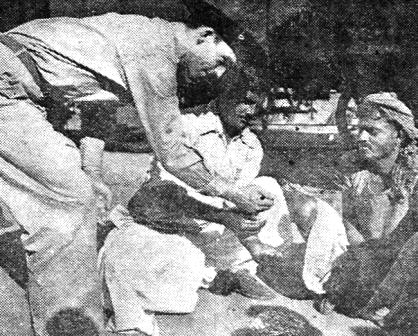 Lt. W. R. Watkins, of Portland, Ore., checks in a coolie at a Base General Depot in Calcutta. It's a new
version of the old shell game but this time no one gets gypped. The coolies receive a certain number of
shells for every trip made carrying material from the warehouse. At the end of the day the coolie cashes
in the shells for hard cash.
Lt. W. R. Watkins, of Portland, Ore., checks in a coolie at a Base General Depot in Calcutta. It's a new
version of the old shell game but this time no one gets gypped. The coolies receive a certain number of
shells for every trip made carrying material from the warehouse. At the end of the day the coolie cashes
in the shells for hard cash.
|
ATC MEDICO G.I.'S PAL;
JABS ONCE - 3 SHOTS
1328TH BU, ATC, INDIA - medical science took another step forward recently, thanks to far-sighted and ambitious Maj. Frank B. "One Shot" Waldorf, Base Surgeon of this ICD base.
Waldorf has perfected a new and revolutionary immunization system, whereby three different serums, typhus, cholera and typhoid, can be given in one shot from the hypodermic needle. Instead of giving three individual shots, the surgeon combines one cubic centimeter each of typhus and cholera and one-half cc of typhoid in one syringe and lets the nervous G.I. have the whole works in one jab.
Surprisingly, this new method is hailed by the victims as one of the grandest inventions of medical science, for there is actually less unfavorable after effect and less pain.
Waldorf is rightly proud of his system because it reduces one-third the number of needles, syringes and other supplies that are used. Too, more accurately measured doses can be filled because large amounts of the combined serum are prepared at one time and this eliminates the possibility of human error to a greater degree.
After the first batch of mixed serum had been made and tested, the major became the first guinea pig. Then his assistant, Capt. Claude L. Houck, and four enlisted men volunteered for injections. They were followed on the testing block by 100 volunteers from the Ordnance Section. Last came the entire field personnel, after which the combined immunization system was officially called a success.
"One Shot" Waldorf states that he has never seen nor heard of any official Army use of his method before, but he refused to go out on a limb and say he is the first.
The Roundup still says you can't beat Yankee you-know-what.
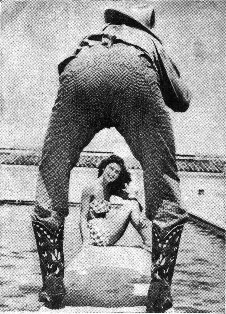 The scene, Miami. The photographer, a cowboy. From where we don't know, but from the legs we'd say Texas and
not Brooklyn. The subject, Martha Gray. It's a good angle.
The scene, Miami. The photographer, a cowboy. From where we don't know, but from the legs we'd say Texas and
not Brooklyn. The subject, Martha Gray. It's a good angle.
|
'TAR HEEL TWINS,'
TOGETHER FOR 2 YEARS,
FLY IN BURMA
H.Q., 10TH AIR FORCE, BURMA - A pair of transport pilots of the Tenth Air Force's Second Troop Carrier Squadron in North Burma, were recently dubbed "The Tarheel Twins" when the latest in a series of coincidences that has kept them together since they left North Carolina early last year brought each of them the Distinguished Flying Cross and promotion to first lieutenants, on the same orders.
The two officers are Lt. Bon C. Hinson, Jr., and Lt. Hugh P. McDonald, both of Charlotte, N.C.
As air cadets, they traveled together in January of 1943 from Charlotte to Miami Beach, Fla., where they happened to be assigned to the same squadron for their first month's training. From there, they were sent to the College Training Detachment at Memphis State College, Memphis, Tenn., for two months.
Still together, Lt. Hinson and lt. McDonald went to San Antonio, Tex., for classification and preflight, and then from there to Sikeston, Mo., for primary training. By added coincidence, during basic training at Strother Field, Winfield, Kans., both flew with the same instructor. Following the two-month advanced course, the two received their wings and commissions as second lieutenants in the same class, on March 12, 1944, and remained as instructors until June when they came overseas.
Reaching the Tenth Air Force, the pair found themselves both assigned to Second Troop Carrier Squadron, with the job of flying vitally needed supplies to American, British and Chinese troops in North Burma. Lt. McDonald was the first to be checked out as a first pilot; five days later, Lt. Hinson followed suit. Lt. Hinson, having accumulated more than 100 hours of combat flying in September, was the first to be awarded the Air Medal, but an identical award to Lt. McDonald came along three days afterwards.
Coincidence again took a hand at this point. In November, the same orders awarded the first Oak Leaf Cluster to the Air Medal to Lt. Hinson and Lt. McDonald, and in December each received the Distinguished Flying Cross on the same day, after completing more than 300 hours of combat flying. Came February 1, and Second Troop promotion orders made the two pilots first lieutenants.
Lt. Hinson and Lt. McDonald are tent mates at Second Troop, and their present hope is to see their names together on orders sending them back to the States in the not too distant future.
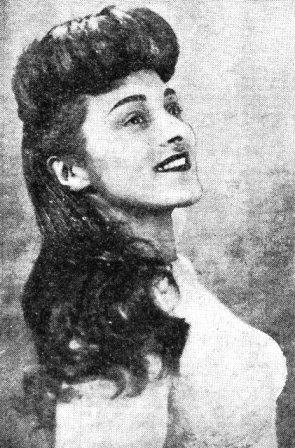 Meet Miss Bobbye Jones, beautiful Negro dramatic student of Pasadena, Calif. Miss Jones, 22 years old, is
a graduate of Pasadena Junior College. When it comes to being photogenic, she rates 1-A in our book.
Meet Miss Bobbye Jones, beautiful Negro dramatic student of Pasadena, Calif. Miss Jones, 22 years old, is
a graduate of Pasadena Junior College. When it comes to being photogenic, she rates 1-A in our book.
|
Yank Handyman Supplies Water
For ATC Station
1329 BU, ATC, ASSAM - T/Sgt. Ridley Brown, lone member of the utilities section here, has been performing wonders - doing everything from keeping the roads repaired to fixing the water system.
An acute personnel shortage left brown in charge of the several Indian laborers and four former fire fighters temporarily assigned to him, but all of these were inexperienced. All the work on the base is closely supervised by Brown, who was a pre-war automobile mechanic and frequently he finds it easier to do the job himself when the going gets rough.
WHERE OTHERS FAIL
With a limited education that ended in high school, Brown does not claim to be an engineer, but he dug into the heart of the maps and blue prints of the base piping system during a recent water shut-off, and he found the cut-off valves after everybody else on the base had failed. Using the process of elimination, he narrowed the trouble down to a certain area, but that was the only place for which there was no diagram.
The sergeant used his strong arms as well as his head at this point, and he turned out mounds of dirt at logical points where the cut-off might have occurred. After hours of slaving in the morning darkness, he came to a spot where there had been other underground construction work.
'BAD LUCK'
Digging down he came to a section of pipe that apparently was causing the trouble. This uncharted shut-off connection had been closed for other work by thoughtless workers who forgot to turn it back on. Further hard luck had added to the complication when the valve was accidentally covered by Indian workers who had been ordered to fill up another section of ground. All Brown had to do here was to turn the lever, and water flowed once more over the base.
Three I-B Generals Receive Citations For Aerial Activity
Three India-Burma general officers made the honors list recently. Maj. Gens. George E. Stratemeyer and Howard C. Davidson being awarded the Air Medal while Brig. Gen. James W. Spry, Air Service Command Chief of Staff, was granted both an Air Medal and a Legion of Merit in a few days time.
Stratemeyer, Eastern Air Command chief, was cited for more than 100 hours' flight over enemy territory, including some operational missions, receiving an Oak Leaf Cluster for a previously awarded Air Medal. Davidson's flight over Jap North Burma installations in unarmed aircraft won his award, while Spry's Air Medal was in recognition of numerous Hump flights.
The Legion of Merit, fourth ranking U.S. award, went to Spry for his outstanding performance in setting up ASC bases to link India, Burma and China and maintain the flow of supplies for aerial operations.
|
Collier's Artist Back In Orient To Sketch G.I.
When Martha Sawyers Reusswig was in Peiping, China, at the beginning of the Sino-Japanese War she didn't dream that she would be back in 1945 to paint the American G.I. against a Far Eastern background.
But she is back here now. Her mission is to portray the Yank in the Orient for Collier's magazine. She is scheduled to do a series of illustrations in India, Burma and China for cover use.
Miss Sawyers is recognized as the outstanding illustrator on the Far East. Most of you will probably remember the Pearl Buck stories in Collier's and the vivid and lifelike illustrations that accompanied them. They were all the work of Miss sawyers, who also did the art backgrounds for the works of Roy Chapman Andrews, Mona Gardner and W. B. Courtney.
The petite Collier's artist became interested in her present line of work following her marriage to Bill Reusswig, well known King Features illustrator, who is soon due in this Theater after having been with Lt. Gen. George S. Patton's Third Army in the ETO.
KNOWS JAPAN
She had been in China, Java and Sumatra, but after the outbreak of hostilities between Nippon and China she returned to the States after spending a month in Japan.
Miss Sawyers says life seems to be moving at a faster tempo in the Orient than when she was here last. "I don't know how much influence the American soldier has had on that, but I believe he has speeded up things," she said. "I'll have to re-orient myself to the Orient, for sketching the active American against the background of the languid East will require some readjustments. What I am after is primarily human interest, featuring the American soldier in the Far East."
NATIVE TEXAN
Miss Sawyers is a native of Cuero, Tex. She innocently passed a remark that confirmed the suspicions of many New Yorkers when she said, "This country reminds me of Texas, especially the brush." We told her that there was one Texas combat unit here, the 124th Cavalry, part of the Mars Task Force, and that they had helped make battle history in Burma.
She proved herself a true Texan by remarking that Texans make battle history wherever they go.
|
Hurricane Hits XX Bomb Bases;
158 Casualties
HQ., XX BOMBER COMMAND, INDIA - About 50 members of the XX Bomber Command have been hospitalized, with about 100 others receiving dispensary treatment as a result of the storm that swept bases near here on the night of March 12, killing eight members of the B-29 units.
In Addition, between 20 and 25 airplanes are being repaired after being hurled around by the winds. None of the wrecked and partially-wrecked planes were Super-Forts.
The full force of the storm was felt at only one base, where winds of hurricane intensity collapsed a number of buildings. All of the deaths and most of the injuries were caused by falling walls and roofs. Many airplanes were picked up like leaves and scattered about.
Damage to aircraft and buildings was comparatively minor at other bases.
Pilot's Widow Spurns Medal
NEWARK, N.J. - (ANS) - The widow of a fighter pilot killed in the Southwest Pacific this week declined an invitation to ceremonies for presentation of an Air Medal posthumously awarded to her husband, saying "Since he's not alive to receive it, all the meaning of the medal is gone for me."
The widow asked that no names be revealed as his invalid mother hasn't learned of his death, and it was feared the shock would be too great for her to bear.
In declining to attend the presentation ceremonies, the widow wrote Army authorities, "I am used to the Government leaving things at my door, the telegram, the Purple Heart. So I won't mind the Air Medal coming through the mail."
The Roundup is a weekly newspaper of the United States Forces, published by and for the men in Burma and India, from news and pictures supplied by staff members, soldier correspondents, United Press, OWI, and Army News Service. The Roundup is published Thursday of each week and is printed by The Statesman in New Delhi and Calcutta, India. Editorial matter should be sent directly to Capt. Floyd Walter, Hq., U.S.F., I.B.T., New Delhi, India, and should arrive not later than Sunday in order to be included in that week's issue. Pictures must arrive by Saturday and must be negatives or enlargements. Stories should contain full name and organization of sender. Complaints about circulation should be sent directly to Lt. S.R. Rose, Hq., U.S.F., I.B.T., New Delhi, India. Units on the mailing list should make notification of any major change in personnel strength or any change of APO.

MARCH 22, 1945
Original issue of India-Burma Theater Roundup shared by CBI veteran Roger Cook
Copyright © 2008 Carl Warren Weidenburner
TOP OF PAGE PRINT THIS PAGE ABOUT THIS PAGE SEND COMMENTS
PREVIOUS ISSUE CLOSE THIS WINDOW NEXT ISSUE
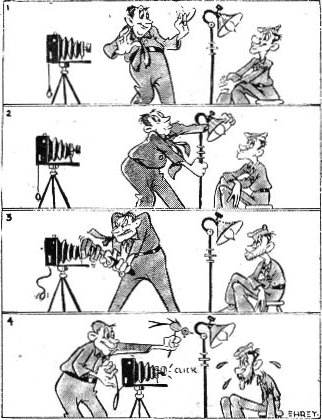
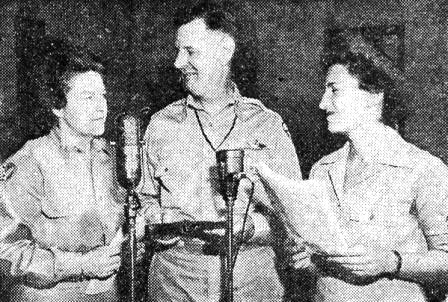 Making a recording for Yanks In The Orient are (left to right) Maj. Betty Clague, Milwaukee, WAC director;
Maj. Gen. George E. Stratemeyer, and Cpl. Dorothy Gelles, Trenton, N.J. The program was designed to let the States
know how the WAC's live at Stratemeyer's Eastern Air Command headquarters. The program is scheduled for the
Blue Network this month.
Making a recording for Yanks In The Orient are (left to right) Maj. Betty Clague, Milwaukee, WAC director;
Maj. Gen. George E. Stratemeyer, and Cpl. Dorothy Gelles, Trenton, N.J. The program was designed to let the States
know how the WAC's live at Stratemeyer's Eastern Air Command headquarters. The program is scheduled for the
Blue Network this month.
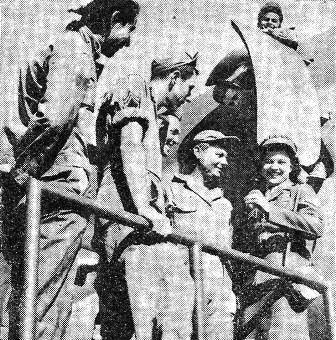 Believe it or not, but these G.I.'s are instructors. The local WACI makes the Agra Depot a regular course in recruit training programs. Drooling from left to right are Cpl. Uhrin, T/Sgt. Kramer, Cpl. Stewart, S/Sgt. Kuntz, Cpl. Bragonier and Sgt. Wagner. The gal's name is Jeanie. The PRO evidently kept introductions on a very formal basis since he didn't give the first name of the G.I.'s or the last name of the WACI.
Believe it or not, but these G.I.'s are instructors. The local WACI makes the Agra Depot a regular course in recruit training programs. Drooling from left to right are Cpl. Uhrin, T/Sgt. Kramer, Cpl. Stewart, S/Sgt. Kuntz, Cpl. Bragonier and Sgt. Wagner. The gal's name is Jeanie. The PRO evidently kept introductions on a very formal basis since he didn't give the first name of the G.I.'s or the last name of the WACI.
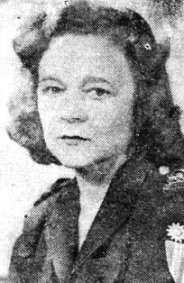 Martha Sawyers Reusswig, famed illustrator of the Far East, is back in the Orient, this time to sketch the
American soldier in this theater.
Martha Sawyers Reusswig, famed illustrator of the Far East, is back in the Orient, this time to sketch the
American soldier in this theater.
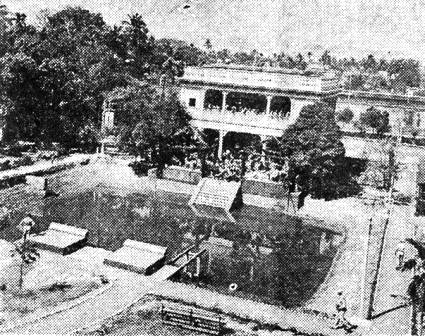 Here is a general view showing part of formal opening ceremony for the new Negro Rest Camp in Calcutta.
This scene is taking place in front of the Red Cross building.
Here is a general view showing part of formal opening ceremony for the new Negro Rest Camp in Calcutta.
This scene is taking place in front of the Red Cross building.